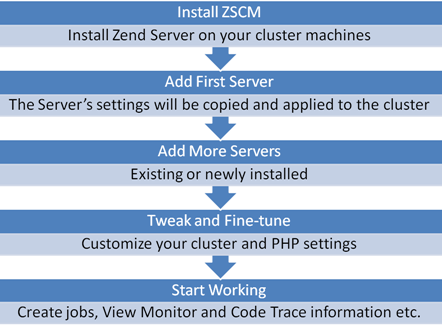The following list describes the initial configuration tasks that you can do with Zend Server Cluster Manager. Some of these tasks depend on if you already have Zend Server installed on a server or servers or if you are building a cluster and starting with Zend Server Cluster Manager.
If you have not yet installed Zend Server Cluster Manager see Running the Zend Server Cluster Manager Installation.
ZSCM-IG-030112-5.6-01
Once Zend Server Cluster Manager is installed you can start configuring
your settings. If you are using settings from a previously configured
Zend Server you may not have to make any changes to your settings although
you may want to check your events to see that they are generating at optimal
levels and if necessary modify event thresholds. See
for more information on the monitoring workflow.
If you have installed and created a cluster and you have not previously configured any settings you will be running on default settings. The default settings are as follows:
Zend Session Clustering is in standby mode on the servers.
For a complete list of components see
Zend Server Cluster Manager can be installed on one of the following operating systems Linux and Windows. A cluster can be created when you add servers to be managed by Zend Server Cluster Manager.
You may already have Zend Server installed on one ore more machines so you can to create a cluster out of the existing servers. Alternatively, you may have a group of severs with no connection between them and you want to turn them into a cluster.
Note:
A cluster managed by Zend Server Cluster Manager can only consist of servers that are running the same operating system and major Zend Server version.
The following image describes the installation process, click on an area in the diagram or on the list below for more information about each step.

For instructions on installing Zend Server Cluster Manager see Installing
Zend Server Cluster Manager. If you want to know how to install Zend
Server see
Adding a server is a process of associating a server running Zend Server to a cluster by using Zend Server Cluster Manager. If you already have servers running Zend Server, click here for instructions on how to add a server.
Note:
To add a server you must know the Server's IP address and the Zend Server login password - that is defined upon initial login after installation.
There are three types of rules that you can configure in Zend Server Cluster Manager. Monitoring. Caching and Recurring Jobs. These rules, when configured will be applied to all servers in your cluster. Moreover, all information collected about them will be aggregated and displayed in Zend Server Cluster Manager.
Information on configuring your PHP and your cluster can be found in the Zend Server Reference Manual as follows:
Code Tracing, Components, Extensions, Directives, Debugger, Monitor and Job Queue with the exception of Servers and Session Clustering which are only found in Zend Server Cluster Manager.
© 1999-2013 Zend Technologies, Ltd. All rights reserved.